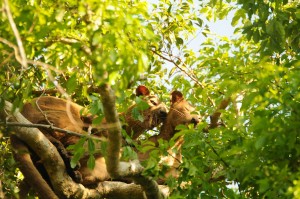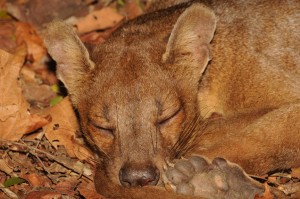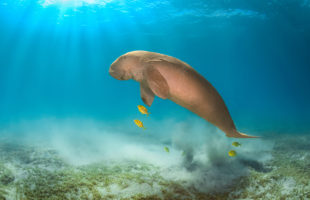Indeed it looks a little strange: The Fossa (Cryptoprocta ferox). The long-stretched body wears a thick tail of almost equal length, and the cat-like head is graced by quite sharp teeth and a big, round nose. And although the Fossa grows only knee-high, it is Madagascar’s largest predator. Both genders reach a maximum body weight of 12 kg, the males are akways heavier and bigger than their female counterparts. Fossas move adroitly and safely in the trees and climb excellently, but also inhabit burrows. On the ground, it moves on its toes. In contrast it uses its soles to climb in the branches and have more grip. And there are even more odd things that make the Fossa a worldwide peerless animal: As a so-called cathemeral predator, it belongs to few species on Earth that have no distinct circadian rhythm. Fossas will simply be awake if it fits their needs and mood!

The Fossa has been living longer on Madagascar than people settled the red island. Today like long ago they inhabit vast territories of up to 25 km². Females are a little more modest and have territories of half this size. They vehemently defend their home zones and usually mark all borders with their anal scent glands. The diet of this elegant hunter mainly consists of meat, in the form of primarily lemurs, other small mammals like tencres or reptiles and frogs. Some insects that come along the hunting path will not be scorned either.
Mating time of the Fossa begins in September and lasts into november, to the beginning of the rainy season. It is the only time of the year that the Fossa searches the forests for the likes of it – otherwise they are strict loners. The females look for thick, exposed branches, where they can sit enthroned for a week. The males seek these trees, fight for the right to mate and try to mate the chosen female. But those have a mind of their own: They chase away candidates that do not please them, and choose their own favorites to mate with. The copulation itself can take up to three hours, which might be one of the longest matings in animal kingdom. In the course of this, the two partners will begin to tie (the male cannot drag his penis from the female’s vagina for a while), which is actually known only from dogs and wolves. Most matings take place in the treetops, and in some places in Madagascar, e.g. Kirindy, you can watch these well.
In December or January, the young Fossas are born and raised. It is not before the age of one year that the youngsters separate from their mother. The females can bear only every other year, and get two to four babies maximally. Those are sexually mature with three or four years only, which makes the Fossa’s reproduction rate very low. The small Fossas open their eyes for the first time with two or three weeks – quite late for a mammal – and leave their birth cavity with almost five months for their first journeys.

Young fossas have another strange feature, that is known of no other mammal on Earth: Young females develop male sexual characteristis. This disappears later on when grown up. Additionally, the female Fossas have a clitoris bone, similar to the penis bone of males. Youngs of both genders have orange bellies, coloured by scent glands. Females lose this color and become beige with sexual maturity. The sense of this masculinization remains unclear. Some scientists suggest it makes the females less attractive for adult males’ sexualt assaults.
Originally, the small predator was distributed all over Madagascar. Today, it is retricted to the residual forests, that keep being splitted and disturbed by human settlements and slash-and-burn agriculture. At least Fossas can adapt to dry forests as well as rainforests, and inhabit savannahs and spiny forests like different altitudes from sea level up to 2600 m. Adaptability has become a very important character of the Fossa – besides its many other strance features. In some areas, the animals are hunted due to their bad reputation as hen thieves. Meanwhile, the Fossa already counts as a threatened species, because it only occurs in Madagascar, and becomes more and more rare on the island.
 MADAMAGAZINE Your Magazine about Madagascar
MADAMAGAZINE Your Magazine about Madagascar




